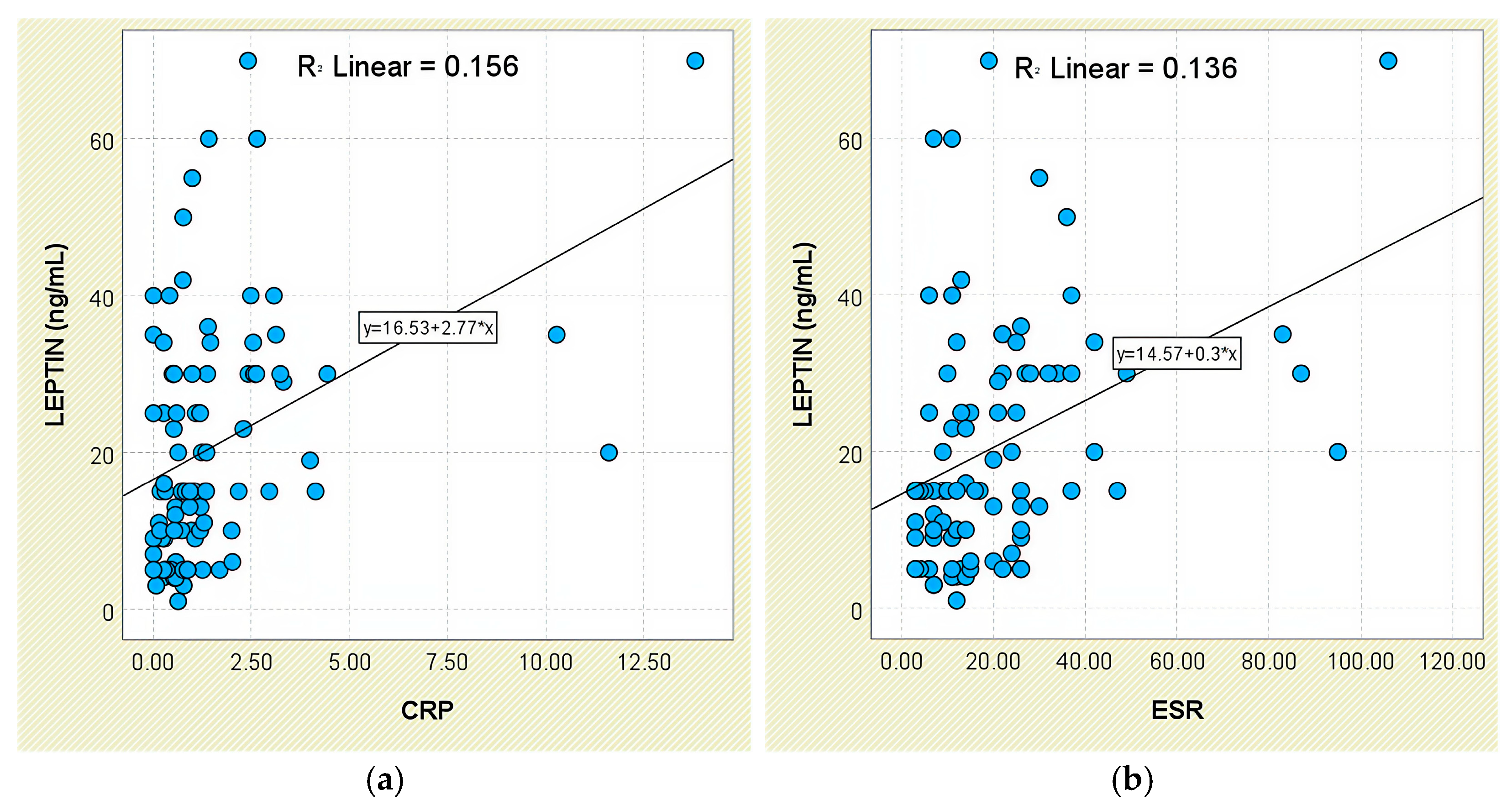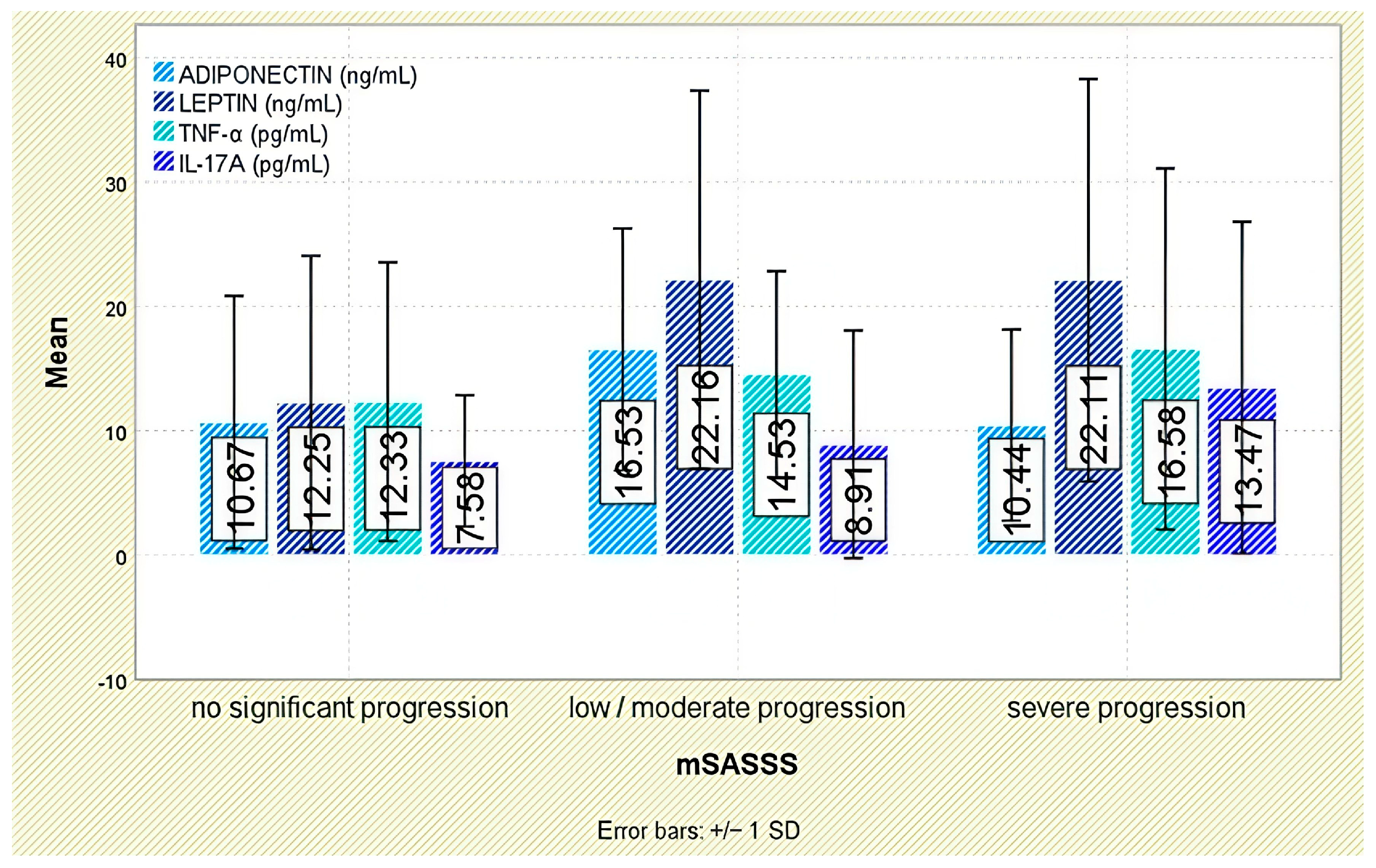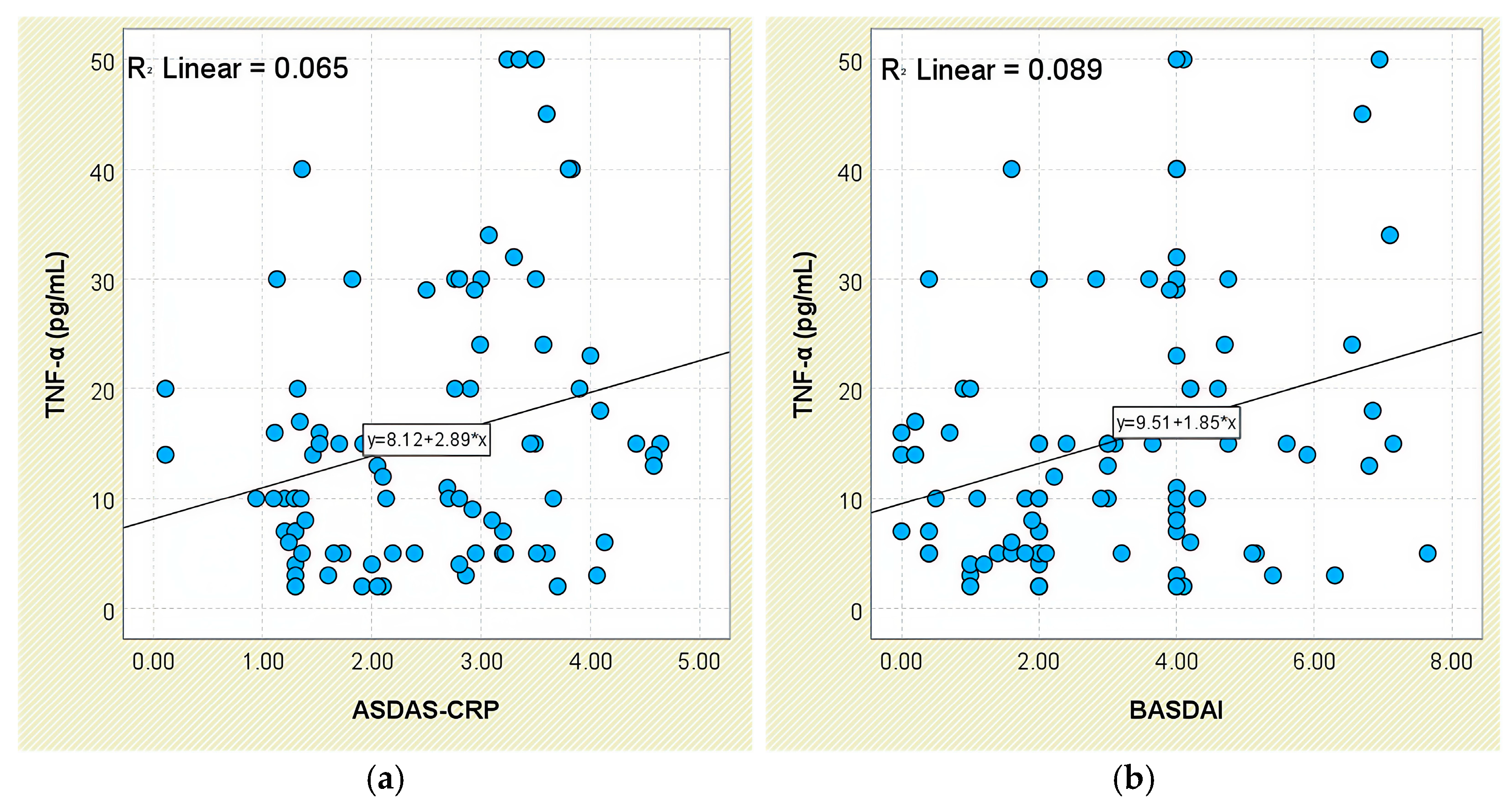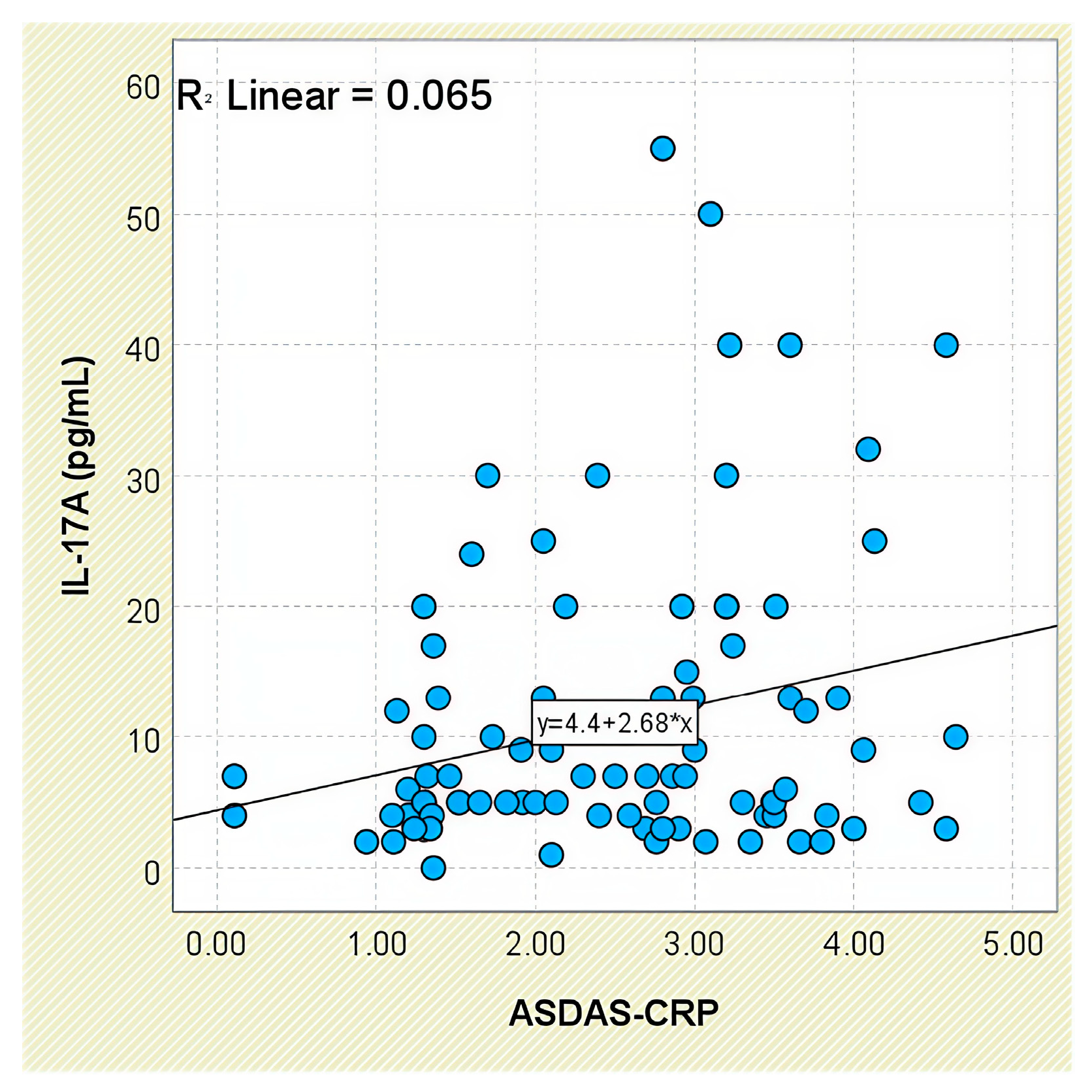Biomarkers of Inflammation and Radiographic Progression in Axial Spondyloarthritis: A Clinical Evaluation of Leptin, Adiponectin, TNF-α, and IL-17A
Abstract
1. Introduction
2. Materials and Methods
2.1. Study Design and Subjects
2.2. Clinical, Laboratory, and Radiographic Assessments
2.3. Serum Biomarkers
2.4. Statistical Analyses
3. Results
3.1. Patient Demographics, Disease-Related Characteristics, and Comorbidities
3.2. Biomarker Results
3.2.1. Leptin in axSpA
3.2.2. Adiponectin in axSpA
3.2.3. TNF-Alpha in axSpA
3.2.4. IL-17A in axSpA
4. Discussion
4.1. Leptin: A Marker of Inflammation and Structural Progression
4.2. Adiponectin: An Anti-Inflammatory Modulator
4.3. TNF-α: A Key Inflammatory Cytokine with Limited Structural Correlation
4.4. IL-17A: Subtle Contributions to Inflammation and Ossification
4.5. Perspectives on Novelty and Clinical Relevance
4.6. Study Limitations
4.7. Future Directions
5. Conclusions
Supplementary Materials
Author Contributions
Funding
Institutional Review Board Statement
Informed Consent Statement
Data Availability Statement
Acknowledgments
Conflicts of Interest
Abbreviations
| SpA | Spondyloarthritis |
| NSAIDs | Nonsteroidal Anti-Inflammatory Drugs |
| axSpA | Axial Spondyloarthritis |
| r-axSpA | Radiographic Axial Spondyloarthritis |
| AS | Ankylosing Spondylitis |
| nr-axSpA | Non-radiographic Axial Spondyloarthritis |
| TNF-α | Tumor Necrosis Factor-alpha |
| IL | Interleukin |
| JAK | Janus kinase |
| ASDAS-CRP | Ankylosing Spondylitis Disease Activity Score based on C-reactive protein |
| BASDAI | Bath Ankylosing Spondylitis Disease Activity Index |
| mSASSS | Modified Stoke Ankylosing Spondylitis Spine Score |
| CRP | C-reactive protein |
| ESR | Erythrocyte Sedimentation Rate |
| NF-κB | Nuclear Factor kappa-light-chain-enhancer of activated B cells |
| MAPKs | Mitogen-Activated Protein Kinases |
| TMB | Tetramethylbenzidine |
References
- Agrawal, P.; Machado, P.M. Recent advances in managing axial spondylarthritis. Fac. Rev. 2020, 9, 697. [Google Scholar]
- Poddubnyy, D.; Sieper, J. Treatment of Axial Spondyloarthritis: What Does the Future Hold? Curr. Rheumatol. Rep. 2020, 22, 47. [Google Scholar] [CrossRef] [PubMed]
- Poddubnyy, D. Classification vs. diagnostic criteria: The challenge of diagnosing axial spondyloarthritis. Rheumatology 2020, 59, 6–17. [Google Scholar] [CrossRef]
- Ivanova, M.; Zimba, O.; Dimitrov, I.; Angelov, A.K.; Georgiev, T. Axial Spondyloarthritis: An overview of the disease. Rheumatol. Int. 2024, 44, 1607–1619. [Google Scholar] [CrossRef]
- Toussirot, E. The Influence of Adipokines on Radiographic Damage in Inflammatory Rheumatic Diseases. Biomedicines 2023, 11, 536. [Google Scholar] [CrossRef]
- Navarro-Compan, V.; Sepriano, A.; El-Zorkany, B.; van der Heijde, D. Axial spondyloarthritis. Ann. Rheum. Dis. 2021, 80, 1511–1520. [Google Scholar] [CrossRef]
- Maksymowych, W.P. Biomarkers for Diagnosis of Axial Spondyloarthritis, Disease Activity, Prognosis, and Prediction of Response to Therapy. Front. Immunol. 2019, 10, 305. [Google Scholar] [CrossRef] [PubMed]
- Reveille, J.D. Biomarkers for diagnosis, monitoring of progression, and treatment responses in ankylosing spondylitis and axial spondyloarthritis. Clin. Rheumatol. 2015, 34, 1009–1018. [Google Scholar] [CrossRef] [PubMed]
- Lorenzin, M.; Ometto, F.; Ortolan, A.; Felicetti, M.; Favero, M.; Doria, A.; Ramonda, R. An update on serum biomarkers to assess axial spondyloarthritis and to guide treatment decision. Ther. Adv. Musculoskelet. Dis. 2020, 12, 1759720X20934277. [Google Scholar] [CrossRef]
- Jang, D.I.; Lee, A.H.; Shin, H.Y.; Song, H.R.; Park, J.H.; Kang, T.B.; Lee, S.R.; Yang, S.H. The Role of Tumor Necrosis Factor Alpha (TNF-α) in Autoimmune Disease and Current TNF-α Inhibitors in Therapeutics. Int. J. Mol. Sci. 2021, 22, 2719. [Google Scholar] [CrossRef]
- Osta, B.; Benedetti, G.; Miossec, P. Classical and Paradoxical Effects of TNF-α on Bone Homeostasis. Front. Immunol. 2014, 5, 48. [Google Scholar] [CrossRef] [PubMed]
- Corbett, M.; Soares, M.; Jhuti, G.; Rice, S.; Spackman, E.; Sideris, E.; Moe-Byrne, T.; Fox, D.; Marzo-Ortega, H.; Kay, L.; et al. Tumour necrosis factor-α inhibitors for ankylosing spondylitis and non-radiographic axial spondyloarthritis: A systematic review and economic evaluation. Health Technol. Assess. 2016, 20, 1–334. [Google Scholar] [CrossRef]
- McGonagle, D.G.; McInnes, I.B.; Kirkham, B.W.; Sherlock, J.; Moots, R. The role of IL-17A in axial spondyloarthritis and psoriatic arthritis: Recent advances and controversies. Ann. Rheum. Dis. 2019, 78, 1167–1178. [Google Scholar] [CrossRef]
- Toussirot, E. Mini-Review: The Contribution of Adipokines to Joint Inflammation in Inflammatory Rheumatic Diseases. Front. Endocrinol. 2020, 11, 606560. [Google Scholar] [CrossRef]
- Mancuso, P. The role of adipokines in chronic inflammation. Immunotargets Ther. 2016, 5, 47–56. [Google Scholar] [CrossRef]
- Robinson, K.; Prins, J.; Venkatesh, B. Clinical review: Adiponectin biology and its role in inflammation and critical illness. Crit. Care 2011, 15, 221. [Google Scholar] [CrossRef] [PubMed]
- Williams, G.A.; Wang, Y.; Callon, K.E.; Watson, M.; Lin, J.M.; Lam, J.B.; Costa, J.L.; Orpe, A.; Broom, N.; Naot, D.; et al. In Vitro and in Vivo Effects of Adiponectin on Bone. Endocrinology 2009, 150, 3603–3610. [Google Scholar] [CrossRef]
- Park, M.C.; Chung, S.J.; Park, Y.B.; Lee, S.K. Pro-inflammatory effect of leptin on peripheral blood mononuclear cells of patients with ankylosing spondylitis. Jt. Bone Spine 2009, 76, 170–175. [Google Scholar] [CrossRef] [PubMed]
- Gonzalez-Lopez, L.; Fajardo-Robledo, N.S.; Saldaña-Cruz, M.; Moreno-Sandoval, I.V.; Bonilla-Lara, D.; Zavaleta-Muñiz, S.; Nava-Zavala, A.H.; Hernandez-Cuervo, P.; Rocha-Muñoz, A.; Rodriguez-Jimenez, N.A.; et al. Association of adipokines, interleukin-6, and tumor necrosis factor-α concentrations with clinical characteristics and presence of spinal syndesmophytes in patients with ankylosing spondylitis: A cross-sectional study. J. Int. Med. Res. 2017, 45, 1024–1035. [Google Scholar] [CrossRef]
- Zhang, M.Y.; Dini, A.A.; Yang, X.K.; Li, L.J.; Wu, G.C.; Leng, R.X.; Pan, H.F.; Ye, D.Q. Association between serum/plasma adiponectin levels and immune-mediated diseases: A meta-analysis. Arch. Dermatol. Res. 2017, 309, 625–635. [Google Scholar] [CrossRef]
- Mahendran, B.; Sankalingam, R.; Mohanasundaram, K.; Sankaran, S.; Mani, M.; Chilukuri, B. THU0387 Serum Levels of TNF Alpha and VEGF as Markers of Disease Activity in Patients with Axial Spondyloarthritis. Ann. Rheum. Dis. 2016, 75, 328. [Google Scholar] [CrossRef]

















| Characteristics | AxSpA (n = 89) | |
|---|---|---|
| Demographic data | Age (years) | 50.49 ± 12.48 |
| Male patients, n (% of 89) | 64 (71.9%) | |
| BMI, median (IQR), kg/m2 | 26.95 ± 5.31 | |
| Smokers (current, ex), n (%) | 25 (28.1%) | |
| Genetic profile | HLA-B27-positive, n (%) | 46 (51.7%) |
| Disease-related data | Disease duration, months, median (IQR) | 114.31 ± 103.79 |
| Peripheral arthritis, n (%) | 15 (16.9%) | |
| ASDAS-CRP, mean ± SD | 2.48 ± 1.08 | |
| BASDAI (0–10), mean ± SD | 3.11 ± 1.96 | |
| Lumbar flexion (Schober test) (cm) | 13.03 ± 1.86 | |
| Finger-to-floor distance (cm) | 23.38 ± 15.60 | |
| Inflammatory biomarkers | CRP (mg/dL) | 1.54 ± 2.21 |
| ESR (mm/h) | 20.79 ± 19.13 | |
| TNF-α, pg/mL, median (IQR) | 15.27 ± 12.15 | |
| IL-17, pg/mL, median (IQR) | 11.03 ± 11.32 | |
| Metabolic biomarkers | Leptin (ng/mL, median (IQR) | 20.80 ± 15.52 |
| Adiponectin, ng/mL, median (IQR) | 12.66 ± 9.18 | |
| Lipid profile parameters | TC (mg/dL) | 200.14 ± 45.1 |
| LDL-C (mg/dL) | 120.69 ± 36.03 | |
| Triglycerides (mg/dL) | 122.45 ± 73.95 | |
| Radiographic assessment | mSASS (0-72), mean ± SD | 23.76 ± 28.28 |
| Extra-articular manifestations and comorbidities | Patients with syndesmophytes, n (%) | 39 (43.82%) |
| Uveitis history, n (%) | 11 (12.4%) | |
| IBD history, n (%) | 6 (6.7%) | |
| Psoriasis history, n (%) | 5 (5.6%) | |
| Hypertension history, n (%) | 29 (32.6%) | |
| Dyslipidemia history, n (%) | 32 (36%) | |
| Diabetes mellitus history, n (%) | 15 (16.9%) | |
| Current treatment | NSAIDs | 27 (30.3%) |
| csDMARDs | 5 (5.6%) | |
| ANTI-TNF-alpha | 38 (42.7%) | |
| ANTI-IL-17A | 11 (12.4%) | |
| ANTI-JAK | 6 (6.7%) |
Disclaimer/Publisher’s Note: The statements, opinions and data contained in all publications are solely those of the individual author(s) and contributor(s) and not of MDPI and/or the editor(s). MDPI and/or the editor(s) disclaim responsibility for any injury to people or property resulting from any ideas, methods, instructions or products referred to in the content. |
© 2025 by the authors. Licensee MDPI, Basel, Switzerland. This article is an open access article distributed under the terms and conditions of the Creative Commons Attribution (CC BY) license (https://creativecommons.org/licenses/by/4.0/).
Share and Cite
Diaconu, A.-D.; Șorodoc, L.; Pomîrleanu, C.; Foia, L.G.; Șorodoc, V.; Lionte, C.; Russu, M.; Lăpuște, V.; Ghemiș, L.; Ancuța, C. Biomarkers of Inflammation and Radiographic Progression in Axial Spondyloarthritis: A Clinical Evaluation of Leptin, Adiponectin, TNF-α, and IL-17A. J. Clin. Med. 2025, 14, 5605. https://doi.org/10.3390/jcm14155605
Diaconu A-D, Șorodoc L, Pomîrleanu C, Foia LG, Șorodoc V, Lionte C, Russu M, Lăpuște V, Ghemiș L, Ancuța C. Biomarkers of Inflammation and Radiographic Progression in Axial Spondyloarthritis: A Clinical Evaluation of Leptin, Adiponectin, TNF-α, and IL-17A. Journal of Clinical Medicine. 2025; 14(15):5605. https://doi.org/10.3390/jcm14155605
Chicago/Turabian StyleDiaconu, Alexandra-Diana, Laurențiu Șorodoc, Cristina Pomîrleanu, Liliana Georgeta Foia, Victorița Șorodoc, Cătălina Lionte, Mara Russu, Vladia Lăpuște, Larisa Ghemiș, and Codrina Ancuța. 2025. "Biomarkers of Inflammation and Radiographic Progression in Axial Spondyloarthritis: A Clinical Evaluation of Leptin, Adiponectin, TNF-α, and IL-17A" Journal of Clinical Medicine 14, no. 15: 5605. https://doi.org/10.3390/jcm14155605
APA StyleDiaconu, A.-D., Șorodoc, L., Pomîrleanu, C., Foia, L. G., Șorodoc, V., Lionte, C., Russu, M., Lăpuște, V., Ghemiș, L., & Ancuța, C. (2025). Biomarkers of Inflammation and Radiographic Progression in Axial Spondyloarthritis: A Clinical Evaluation of Leptin, Adiponectin, TNF-α, and IL-17A. Journal of Clinical Medicine, 14(15), 5605. https://doi.org/10.3390/jcm14155605








